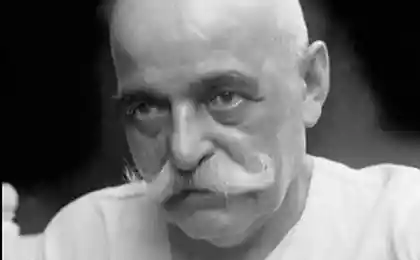759
How to learn to understand your dreams and benefit from them
Each of us have dreams - bright and happy, sometimes disturbing, with exciting stories or disjointed, abstract images. Everyone once in my life, trying to discover the secret of sleep, opened many downers seeking interpretation.
Often the explanation of dream books in relief cause, but sometimes it can cause anxiety, as predicted something negative. The man believes in the prediction and unconsciously adjusts his behavior, thus only helping it come true. So what is a dream and, most importantly, how to understand it?

In psychology, there are several major theories to explain our dreams.
All known Sigmund Freud argued that every dream contains information about our hidden desires.
After him Carl Jung theorized that dreams through symbolic images of the unconscious show the state of our psyche at the moment.
Fritz Perls, founder of Gestalt therapy, considered dreams as unfinished situations messages of public relations, we are with ourselves and the world around them as clues about what we can not see or avoid in life. And also show how we ignore and deny some aspects of his personality. Later, summarizing the idea, Perls called dreams brief reports about the present or the general state of a person's life.
Based on the latest theory, we can say that our emotions, as if the state with the help of the projector shown through objects, events, characters, pieces of scenery, fantastic images that we see in a dream. In some cases, the projection can be even our physical condition, i.e. the work of our internal organs.
"Nightmares" Very often the reason for the feelings become. However, the "scary" stories, too, only a projection, only filled with more energy.
Each person "creates" its own unique images in a dream. With this understanding of dreams becomes apparent absurdity of the whole variety of hobbies Dream book. How, then, to understand their dreams?
There are various techniques for working with dreams, depending on the direction of psychology, in which the psychologist works. As part of Gestalt therapy one of the main techniques is the "identification with the image of a dream", which aims to make the dream more understandable to humans. This technique has a large number of varieties, including exercises that you can perform yourself.
To start record your sleep and make a list of all its parts. Remember each person, each object, each element, and then imagine yourself each. Try to transform into each of these elements and to lose them. A truly become them.
Option 1.
Then take each of these elements, the characters and the pieces and give them the opportunity to communicate with each other. Write a script. Invent a dialogue between two opposing figures - and you'll find (especially if you have correctly identified the opposing party) that they will begin to quarrel with each other. Any part of sleep - it is you, it is your own projection, and if there are some irreconcilable sides, and you get them to fight each other, then you run the game eternal conflict
. As soon as the communication process continues, there is a mutual recognition as long as you finally come to the unity and the reunification of the two opposing forces.
Option 2.
Turned into a dream item, say or write emotional monologue addressed to any other character dreams. After that you need to transfer experienced with the senses, and transfer them to a relationship in real life. Ask yourself this question: Who in my life I could address these feelings
? Option 3.
If the dream is a variety of landscapes, cosmic landscapes, fabulous complex subjects that are difficult to be divided into elements that are very effective art technology. Create drawings, illustrations, collages of your sleep in order to clarify the elements that are designed to your condition. And then, as in the first two cases, tell the dream in the first person, or if there are other elements that enter into dialogue with them.
Option 4.
Draw a dream fragment that interests most of all, select the two elements and draw himself in the same figure. It is useful to choose to exercise not only animals or humans, but also objects or part of the space. Next, make a presentation of the first person of these two elements (Who am I? What am I? What qualities do I have? To which I aspire to? I'm doing in this dream?).
After that, a dialogue in which each element expresses its attitude towards others (including to you in the picture below). Next you yourself applying to each of the elements, and then answer on their behalf. Handle necessarily right, "to you." After that, go back to the experienced emotions and transfer them to your relationship in real life. Who do you drive like a dialogue in real life? Who develop a relationship of this type? What do you want him to get?
It is often difficult to remember the dream as a whole, there's some fleeting images, there are traces of sensations, but sleep did not recall. For this is unchallenging recommendations, following which you can learn to remember dreams in the smallest details:
- Do not get up immediately after wake up, lie down a bit with your eyes closed;
- Carefully listen to yourself, your feelings and images that come to you, do not try to specifically remember the dream;
- Start the "diary" of dreams, which will need to record the resulting images, sensations;
- Better leave the notebook next to the bed so that it was easy to take, reaching out
. What is it for? Understanding dreams may help to have a clear picture of the events in his life, a better understanding of himself. Additionally, you can reduce the negative feelings and emotions, reduce stress, and to maximize the fun, pleasure and joy of life!
Author: Babich Vera Alexandrovna
Often the explanation of dream books in relief cause, but sometimes it can cause anxiety, as predicted something negative. The man believes in the prediction and unconsciously adjusts his behavior, thus only helping it come true. So what is a dream and, most importantly, how to understand it?

In psychology, there are several major theories to explain our dreams.
All known Sigmund Freud argued that every dream contains information about our hidden desires.
After him Carl Jung theorized that dreams through symbolic images of the unconscious show the state of our psyche at the moment.
Fritz Perls, founder of Gestalt therapy, considered dreams as unfinished situations messages of public relations, we are with ourselves and the world around them as clues about what we can not see or avoid in life. And also show how we ignore and deny some aspects of his personality. Later, summarizing the idea, Perls called dreams brief reports about the present or the general state of a person's life.
Based on the latest theory, we can say that our emotions, as if the state with the help of the projector shown through objects, events, characters, pieces of scenery, fantastic images that we see in a dream. In some cases, the projection can be even our physical condition, i.e. the work of our internal organs.
"Nightmares" Very often the reason for the feelings become. However, the "scary" stories, too, only a projection, only filled with more energy.
Each person "creates" its own unique images in a dream. With this understanding of dreams becomes apparent absurdity of the whole variety of hobbies Dream book. How, then, to understand their dreams?
There are various techniques for working with dreams, depending on the direction of psychology, in which the psychologist works. As part of Gestalt therapy one of the main techniques is the "identification with the image of a dream", which aims to make the dream more understandable to humans. This technique has a large number of varieties, including exercises that you can perform yourself.
To start record your sleep and make a list of all its parts. Remember each person, each object, each element, and then imagine yourself each. Try to transform into each of these elements and to lose them. A truly become them.
Option 1.
Then take each of these elements, the characters and the pieces and give them the opportunity to communicate with each other. Write a script. Invent a dialogue between two opposing figures - and you'll find (especially if you have correctly identified the opposing party) that they will begin to quarrel with each other. Any part of sleep - it is you, it is your own projection, and if there are some irreconcilable sides, and you get them to fight each other, then you run the game eternal conflict
. As soon as the communication process continues, there is a mutual recognition as long as you finally come to the unity and the reunification of the two opposing forces.
Option 2.
Turned into a dream item, say or write emotional monologue addressed to any other character dreams. After that you need to transfer experienced with the senses, and transfer them to a relationship in real life. Ask yourself this question: Who in my life I could address these feelings
? Option 3.
If the dream is a variety of landscapes, cosmic landscapes, fabulous complex subjects that are difficult to be divided into elements that are very effective art technology. Create drawings, illustrations, collages of your sleep in order to clarify the elements that are designed to your condition. And then, as in the first two cases, tell the dream in the first person, or if there are other elements that enter into dialogue with them.
Option 4.
Draw a dream fragment that interests most of all, select the two elements and draw himself in the same figure. It is useful to choose to exercise not only animals or humans, but also objects or part of the space. Next, make a presentation of the first person of these two elements (Who am I? What am I? What qualities do I have? To which I aspire to? I'm doing in this dream?).
After that, a dialogue in which each element expresses its attitude towards others (including to you in the picture below). Next you yourself applying to each of the elements, and then answer on their behalf. Handle necessarily right, "to you." After that, go back to the experienced emotions and transfer them to your relationship in real life. Who do you drive like a dialogue in real life? Who develop a relationship of this type? What do you want him to get?
It is often difficult to remember the dream as a whole, there's some fleeting images, there are traces of sensations, but sleep did not recall. For this is unchallenging recommendations, following which you can learn to remember dreams in the smallest details:
- Do not get up immediately after wake up, lie down a bit with your eyes closed;
- Carefully listen to yourself, your feelings and images that come to you, do not try to specifically remember the dream;
- Start the "diary" of dreams, which will need to record the resulting images, sensations;
- Better leave the notebook next to the bed so that it was easy to take, reaching out
. What is it for? Understanding dreams may help to have a clear picture of the events in his life, a better understanding of himself. Additionally, you can reduce the negative feelings and emotions, reduce stress, and to maximize the fun, pleasure and joy of life!
Author: Babich Vera Alexandrovna
Severe weight loss for a long time slows down metabolism
WISP technology: energy from the air and no batteries
























